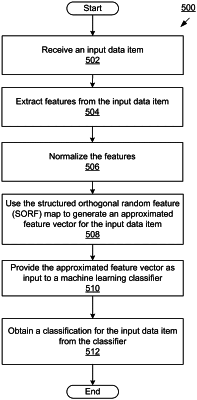| CPC G06N 20/10 (2019.01) [G06F 17/14 (2013.01); G06F 17/16 (2013.01); G06F 17/175 (2013.01); G06F 18/00 (2023.01); G06N 20/00 (2019.01)] | 20 Claims |

|
1. A method, comprising:
performing a classification operation on a first item, including:
generating, by processing circuitry of a computer configured to operate a kernel-based machine learning classifier, a plurality of diagonal matrices, each of the plurality of diagonal matrices having non-diagonal elements that are zero and diagonal elements that have values distributed according to a specified probability distribution function and having a dimension based on a specified dimension;
producing, by the processing circuitry, a plurality of orthogonal matrices, each of the plurality of orthogonal matrices having mutually orthogonal rows;
for each of the plurality of diagonal matrices, forming, by the processing circuitry, a plurality of matrix pairs, each of the plurality of matrix pairs including (i) that diagonal matrix, and (ii) a respective orthogonal matrix of the plurality of orthogonal matrices;
generating, by the processing circuitry, a product of each of the plurality of matrix pairs to produce a linear transformation matrix;
obtaining, by the processing circuitry, an input vector representing the first item from a database, the input vector having the specified dimension;
using the linear transformation matrix to produce an approximated feature vector for the input vector, the approximated feature vector including a nonlinear function of inner products of row vectors of the linear transformation matrix and the input vector; and
providing the approximated feature vector as input into the kernel-based machine learning classifier; and
determining, by the processing circuitry, whether the first item has a particular classification based on an output of the kernel-based machine learning classifier.
|